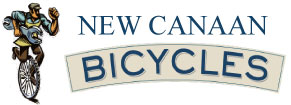Recumbent Bicycles
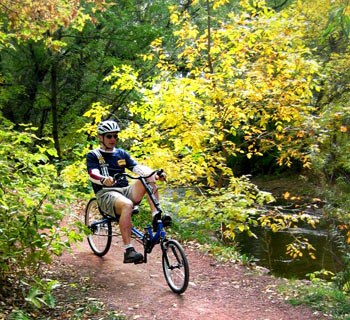 We’re proud to sell a unique type of bicycle that offers a cycling experience unlike any other. They’re called “recumbents,” a word that means reclining, the perfect description for the comfortable La-Z-Boy riding position on these amazing two-wheelers.
We’re proud to sell a unique type of bicycle that offers a cycling experience unlike any other. They’re called “recumbents,” a word that means reclining, the perfect description for the comfortable La-Z-Boy riding position on these amazing two-wheelers.
Gone is the sore rear end, the achy lower back, the numb hands and the stiff neck. Instead you pedal blissfully aboard a virtual rolling lawn chair. And, because you’re reclining, your perspective is completely new. Instead of hunkering over the handlebars staring at the pavement below, you look forward and up. You enjoy the scenery, watch clouds and birds and really see the countryside around you. Also, because you’re not bent over, you can really breathe deeply so you feel fresh and relaxed.
In fact, you’ll probably find yourself riding further than ever and finishing loops with no soreness and little fatigue. When you stop for refreshment on rides, you might even choose to rest while sitting on your bike, which is far more comfortable than the average picnic table or roadside boulder.
Don’t be fooled into thinking recumbents are land yachts simply because they’re so comfortable, though. They’re closer to go-carts in the way you sit low to the ground, feet out front, controls within easy reach. And, the ride is the next best thing to being able to whip around the house on that Big Wheel you had as a kid.
With such impressive attributes, it’s no surprise that recumbents are among our most popular bikes. This guide answers some of the common questions about these sleek machines. Be sure to visit our store to check out some in person and call or email if you have any questions or would like to arrange a test ride.
Space-Age Designs
One of the fascinating things about recumbents is the many available varieties. There are long-, short- and medium-wheelbase models, as well as models with three wheels. You’ll find ‘bents that have handlebars in front of you chopper-style and those that have them beneath you! Seat designs vary, too, though all provide unparalleled support, adjustment and comfort when compared to the seats on upright bikes.
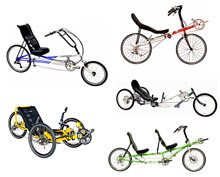 Just like there are touring and racing regular bikes, there are thoroughbred and leisurely recumbents. There are even tandem ‘bents for sharing the experience with your favorite riding partner. A recumbent’s spacious cockpit and ample throne are absolutely liberating—so much so that you can get people on recumbent tandems who might worry about trying a regular tandem.
Just like there are touring and racing regular bikes, there are thoroughbred and leisurely recumbents. There are even tandem ‘bents for sharing the experience with your favorite riding partner. A recumbent’s spacious cockpit and ample throne are absolutely liberating—so much so that you can get people on recumbent tandems who might worry about trying a regular tandem.
Which recumbent design is best for you depends on the type of riding you have in mind and what you’re looking for in a bike. For example, if you ride for fitness at a good clip, you’ll likely lean toward a quick-handling, medium- or short-wheelbase model. If you’re more interested in sightseeing, you’ll probably prefer a more leisurely design, such as something with a longer wheelbase and lots of comfort built in (some models include suspension to absorb road shocks).
Test riding some different bicycles is the best way to get a feel for how they differ and what you like. And keep in mind that, like riders of conventional bikes, many people who buy a recumbent, eventually purchase a second one of a different design in order to double their fun and have a new type to ride.
Brand-New Ride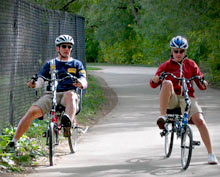
Speaking of riding, it takes a little practice to become adept at recumbent riding. This is because as kids we learn to ride on traditional bicycles, not on recumbents. Which means that when we get on a ‘bent, we try to ride it the way we would our conventional bike. This can make for a wobbly start.
When you ride a recumbent, you sit lower and it’s easier to rest your feet on the ground. Take advantage of this, but be sure to apply the brakes because if you don’t, the bike will roll backwards, which makes it feel like you’re losing control. Before your first ride, just sit there for a bit (be sure to recline so that your back is touching the seat) and get used to the feel of resting your weight in the seat and holding yourself up with your feet while holding the brakes. This is the starting position and how you sit at stop lights.
To ride the bike, put your favorite foot onto the pedal, which should be at about 2 o’clock and push off. But, and this is important—look up and out, NOT down! Looking down is common on conventional bikes, but not on recumbents. 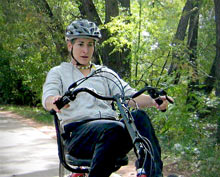 Just look out at the road ahead of you and trust that the bike will balance and you’ll quickly be underway and having the time of your life.
Just look out at the road ahead of you and trust that the bike will balance and you’ll quickly be underway and having the time of your life.
Once you’ve got the knack of balancing the bike, work on relaxing. This comes naturally because the riding position is so comfy, however, if you’re used to a regular bike you might tense up and wrestle with the handlebars the way you might on your upright two-wheeler. This is completely unnecessary and it will cause erratic handling on a recumbent. So, just release any tension and rest your hands gently on the grips and let the bike control itself, which it will do just fine if you let it.
Pedal Power
It’s important to realize that you use slightly different muscles on a recumbent, which means that it takes most riders a few weeks to feel strong climbing and working against headwinds.
You might actually feel stronger when you first get on a recumbent but don’t be fooled. This is the effect of having a backrest to push against. It's a great feature but it can also lead to problems if you abuse it. If you push too hard on the pedals before you’ve built up your recumbent-riding leg muscles, you risk injuring your knees, the same way you can riding a conventional bike.
We recommend using your gears instead of pushing against the seat. This ensures that you build good spinning and pedaling strength in your legs, that your heart and lungs are used efficiently and that you keep those precious knees safe.
It’s also wise to build strength gradually by riding fairly easy gears on flat to rolling courses first and then gradually increasing the distance and hilliness of your rides. Before long you’ll be fit enough to ride everywhere.
Traffic Safety
We think you’ll find that you get plenty of attention on the road due to the recumbent’s unique appearance. Most motorists haven’t seen recumbents and they are more likely to see you. However, because recumbents are lower to the ground, you might wish to add a safety flag to attract attention in traffic.
For riding in traffic, we also recommend getting a mirror. It’s difficult to turn your head and shoulders enough to see behind you and a mirror will give you a good view of what’s going on. One of the nicest things about mirrors is that they let you know when the road behind is clear so you can use more of the lane.
Also, while it’s important to protect yourself with sunblock anytime you’re outdoors, it’s especially important when riding a recumbent. Due to the reclining seating position, more skin is exposed to the sun, such as your face and legs. To prevent sunburn, protect these areas.
Interestingly, some typical safety gear is not required for riding a recumbent. You can ride in any shorts you find comfortable because the seat won’t cause numbness or pain. And, you may find that you don’t even need cycling gloves because little weight is resting on your hands. Also, jerseys with rear pockets aren’t necessary and can actually cause problems with the seams irritating your back as you lean back on them. You will appreciate moisture-transferring fabrics, however, which keep you dry and comfortable.
FAQ
Q: Recumbents sure look weird; don't they require special tools and expertise?
A: While recumbents certainly look different, they are made up of readily available parts and are as easy to maintain and repair as any other bicycle. This means you won’t need any special tools to work on yours and that any shop can provide service, not just ours.
Q: How do I get it around in my car?
A: Depending on the type of ‘bent that you buy, you might need to consider how you’ll transport the bike. Long-wheelbase models, for example, might require a hitch- or roof-type vehicle rack. Some owners prefer to carry their bikes in the back of a van or pick-up. If length makes it difficult to use a particular vehicle rack or trunk, removing the wheels will often solve the problem.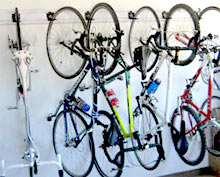
Q: It looks kind of big; where will I store it?
A: Storage is usually as easy as with a conventional bike. We recommend bike hooks, which can be screwed into a stud or joist. Then, you can simply hang the bike from a wheel in a corner of the garage. Even if it’s a long-wheelbase model, it won’t take up much more room hanging like this than a regular two-wheeler.
Q: How are recumbents on hills?
A: The only thing you can't do is stand up when climbing. Instead, you shift into an easy gear and spin comfortably up hills. Different recumbent designs feel differently in the hills and we can point out the right model according to what you're looking for. Also, recumbents aren't any different than regular bikes in that the more you ride in the hills the easier climbing becomes.
Q: Can you carry gear on the bike?
A: Yes! It's possible to install a rack and panniers and some bikes even offer custom bags for more carrying capacity.
We hope this answers most of the questions you have about recumbents. Please call, email or visit if you’d like to learn more about these wonderful bicycles!
